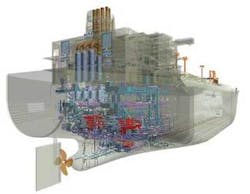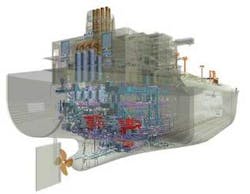Computer applications reach variety of offshore design arenas
Gene Kliewer, Technology Editor
As an example of how the world of computer technology is extending its reach into upstream oil and gas operations, consider Intergraph’s annual users meeting. Examples of how computer programs contribute to efficient upstream petroleum development were regular and varied.
For Intergraph, the Process, Power, and Marine Division is the place to find the connections. Perhaps the most obvious connection comes with the extension of Intergraph’s IntelliShip program as part of the company’s Marine Enterprise developments.
One application of the program comes in an agreement between Intergraph and Lloyd’s Register to build an interface between the IntelliShip design software and Lloyd’s assessment applications. The goal of this cooperative venture is to permit more efficient classification of vessels by Lloyd’s. The interface will enable ship designers to check designs against class requirements more easily and thereby increase front-end design efficiency. The IntelliShip interface will connect with Lloyd’s RulesCalc and ShipRight SDA. It will be developed using the open data exchange tools already contained in Lloyd’s Interface Toolkit.
IntelliShip is integrated 3D modeling, 2D engineering software for shipbuilding. It addresses conceptual and detail design of ships and components, plan approval, production planning, manufacturing, construction, and risk management. It serves as a hub for shared repository of all ship design, construction, and lifecycle management data.
Lloyd’s RulesCalc helps designers comply with the rules and regulations for classification before submitting plans for approval. ShipRight SDA is a structural design assessment program using finite element analyses.
With the program and interface in place, shipyards and designers can check their IntelliShip vessel model against Lloyd’s classification rules to eliminate duplicate modeling and to reduce errors. IntelliShip’s rules-based system allows checks made early in the design cycle to automatically carry over into detailed design and construction. That use of a rules-based system also has design efficiency benefits.
“Creating an interface to our assessment applications is a strategic decision that will drive efficiency and create value for users of both organizations’ software applications,” says Paul Roberts, Lloyd’s Register’s design systems software integration group manager.
Hastening turnaround
Samsung Heavy Industries Co. Ltd. is using Intergraph’s Marine Enterprise products to shorten the time required to design, manufacture, and commission FPSOs and drillships. Samsung’s Geoje Shipyard aims at total turnaround from initial design to completion of construction in 24 months or less, says Yeong-Soo Bae, executive vice president, Shipbuilding Design Division.
“This system has allowed us to change our design/production process,” he says. Working from a single database allows Geoje to simultaneously engineer different parts of the vessels where the company had to follow a one-piece-at-a-time process in the past. With all the data integrated, the designers can talk with both the vessel owner regarding design and also with the production line regarding procedures and schedules, and all the changes resulting from those conferences are fed into a single database available to all participants.
“There is a cost benefit, too,” Bae says, pointing to two places where Samsung saves time using the Marine Enterprise products. The first one is in the simultaneous engineering process, which avoids the typical recycling of information back into the process to accommodate changes made in later parts of the design. The other time savings is in training.
“Training new engineers on the legacy system took from three to eight years,” Bae says. “But now, we cannot wait that long. The Intergraph system allows new engineers to see the design easily and to see what is going on all in one system. And, the (more experienced) project manager can watch over it all since all the groups are working in the same data base.”
Working from this unified database helps to minimize design and production changes, says Sang-Youn Kim, senior manager, outfitting CAD development, Geoje Shipyard. He says using the program has reduced rework errors by 50% and also reduced material costs. Ultimately, Samsung expects to see a 10% increase in productivity arising from applying the technology and from working with Intergraph to address parts of IntelliShip, which Samsung sees could be tailored to further meet its needs.
The rules-based approach also lets the user define any number of specific design sub-elements that can be applied without engineer or designer involvement. For example, the program can be given the “rules” for connecting two pieces of pipe given the pipe size, type, and bend radius. Up to a given pipe size and type, the computer automatically draws in the kind of connection the rule tells it to, whether it is a flange connection, butt-weld, or whatever other choices the designer initially provides.
Aker Offshore experience
On a smaller scale, Aker Offshore Partner AS has applied the 3D modeling capability of Intergraph’s Marine Enterprise products. AOP had developed custom 3D modeling applications for pipe supports because there were no programs specifically for the offshore process design industry. This custom approach was incorporated into Intergraph’s SupportModeler software specifically for offshore oil and gas use.
On the Valhall project, which had 1,000 pipe supports, Aker says the new program reduced the required design workforce, produced higher quality designs, and did it all faster than before.
“Often pipe supports are not taken into consideration until the end of the project,” says Kjell Ankervold, who was responsible for pipe supports on the integrated deck. “That is why it is important to produce high-quality results in a short period of time.”
The support modeling program was integrated into the Intergraph process design program so that the flow of information through the programs became automatic and eliminated manual entry of the information along with the errors that can result from that data entry.
Petrobras applications
Petrobras, Brazil’s national oil company, used IntelliShip on three different types of offshore projects - the PMXL-1 gas platform, theP-55 semisubmersible, and the P-57 FPSO.
“The new procedure eliminated inconsistencies by eliminating much of the manual work,” says Eduardo Perroni of Cenpes. “We now can do 3D modeling from the conceptual design and then go from 3D to 2D drawings for classification.”
The single, unified database is the key element in achieving these new procedures. The ability to go directly from concept to a 3D model and then to produce 2D drawings for certification purposes is a plus to Petrobras, Perroni says. From the 3D model, the project work also can go to hydrodynamic and structural modeling concurrently with production of the 2D drawings.
As with Samsung, Petrobras benefits from the ability to define engineering rules across the board for a specific type of project. For Petrobras, these include fixed platforms, semisubmersibles, and FPSOs. The operator and Intergraph are continuing work on developing full integration between the 3D models and the engineering analyses.

